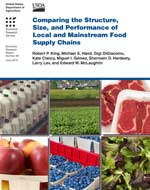Comparing the Structure, Size, and Performance of Local and Mainstream Food Supply Chains
DOI:
https://doi.org/10.5304/jafscd.2010.012.005
Keywords:
Review, Supply Chains, ScaleAbstract
First paragraphs:
Following on the attention generated by a popular local food movement, the necessity—or at least the potential—of growth in local and regional food systems has been widely identified as an important area of focus for food systems analysis and policy.1
The claims about the strengths and benefits of more localized diets and production systems—particularly those made in the promotion of the “locavore” movement—have increasingly come under attack in the mainstream and academic press (Budiansky, 2010; Desrochers & Shimizu, 2008). Much of this debate is grounded in speculative rhetoric and assumptions, as the research needed to support such claims and counterclaims does not yet exist. In North America in particular the debate has suffered from an absence of detailed, comparative research measuring inputs, performance, and outcomes for producers and consumers, in both mainstream and local food systems.
1 See Baker, Campsie, & Rabinowicz, 2010; Harvie & Steffey, 2010; Kirschenmann, Stevenson, Buttel, Lyson, & Duffy, 2008; as well as the special issue of the Cambridge Journal of Regions, Economy and Society (Issue 3, 2010) focusing on “food system (re)-regionalization.”Metrics

Downloads
Published
How to Cite
License
Copyright (c) 2010 Phil Mount

This work is licensed under a Creative Commons Attribution 4.0 International License.
The copyright to all content published in JAFSCD belongs to the author(s). It is licensed as CC BY 4.0. This license determines how you may reprint, copy, distribute, or otherwise share JAFSCD content.












